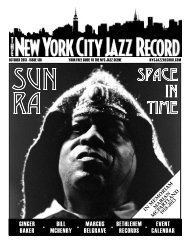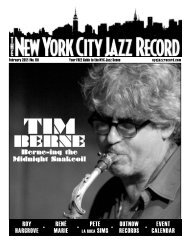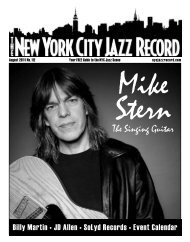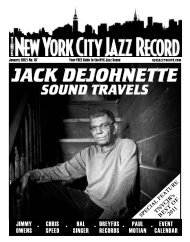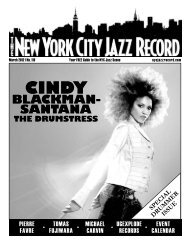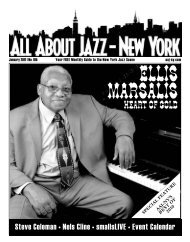September 2012 - The New York City Jazz Record
September 2012 - The New York City Jazz Record
September 2012 - The New York City Jazz Record
You also want an ePaper? Increase the reach of your titles
YUMPU automatically turns print PDFs into web optimized ePapers that Google loves.
Golden Child<br />
Jared Gold (Posi-Tone)<br />
by Sharon Mizrahi<br />
In the vast jazz animal kingdom, few instruments have<br />
as big a personality as the ever-temperamental organ.<br />
It has the power to transform trios and quartets into<br />
“organ bands” and concert halls into portals of funky<br />
soul. But it’s the organ’s transcendent, otherworldly<br />
musical presence that emerges most captivating of all.<br />
Jared Gold’s Golden Child illustrates this charm<br />
through a tangy mix of reinvented standards and<br />
creative originals. As soon as Gold belts out the<br />
opening notes to “A Change Is Gonna Come”, the air<br />
comes alive with groovy zest. Though the organist<br />
assumes a laidback vibe, his approach is laced with<br />
plenty of attitude in the Sam Cooke piece, growing<br />
ever more intricate and bold. Guitarist Ed Cherry’s<br />
coolly electric chords introduce some complex<br />
dynamics to the mix, acting as both a mellow foil and a<br />
fierce contender to the organ. And while Quincy Davis<br />
knocks out several sharp cymbal accents, Gold brings<br />
the tune to newfound acerbic heights.<br />
Gold takes a narrative approach on the Johnny<br />
Nash piece “I Can See Clearly Now”. <strong>The</strong> tune’s classic<br />
refrain resonates through the Hammond B-3, twisted<br />
with a magnetic edginess that persists even in the most<br />
subdued moments. Gold’s musical fire meets its match<br />
in Cherry’s guitar, stirred along by Davis’ rolling<br />
momentum. “I Wanna Walk” further illustrates the<br />
band’s unity, propelled by Gold’s assertive chords.<br />
Even when the trio simmers down to a more<br />
introspective sound, their energy remains innately<br />
gripping. Gold’s own “Pensa Em Mim” unravels<br />
slowly and organically, shrouded in a ghastly hum of<br />
cymbals and guitar. Gold periodically pierces through<br />
the blur with fierce electric uprisings, making the piece<br />
as enthralling as the album’s fast-paced tracks. But<br />
whether the band is feeling energetic or pensive, this<br />
album can’t help but be absolutely golden with a<br />
bandleader as innovative as Jared Gold.<br />
For more information, visit posi-tone.com. Gold is at Bar<br />
Next Door Sep. 8th with Dave Stryker, <strong>Jazz</strong> Standard Sep.<br />
13th with Oliver Lake and Smalls Sep. 25th. See Calendar.<br />
Live at Smalls<br />
Rick Germanson Quartet (featuring Eddie Henderson)<br />
(smallsLIVE)<br />
by Ken Dryden<br />
Rick Germanson has been part of the <strong>New</strong> <strong>York</strong> <strong>City</strong><br />
jazz scene since the late ‘90s, arriving not long after<br />
winning the Grand Prize at <strong>The</strong> American Pianists’<br />
Association <strong>Jazz</strong> Piano Competition. He served as a<br />
sideman with Pat Martino for several years, along with<br />
touring and recording as a part of <strong>The</strong> Cannonball<br />
Legacy Band featuring Louis Hayes. His lengthy<br />
resumé also includes record dates with Wayne<br />
Escoffery, Brian Lynch, Jeremy Pelt, Carolyn Leonhart<br />
and David Gibson. He’s shared the stage with George<br />
Coleman, Tom Harrell, Slide Hampton, Frank Morgan<br />
and Charles McPherson, to name only a few.<br />
Germanson has a self-confidence that proves<br />
infectious on the bandstand. His quartet includes<br />
several veterans of note: trumpeter Dr. Eddie<br />
Henderson, bassist Paul Gill and drummer Lewis<br />
Nash. <strong>The</strong> pianist launches this live set with a driving<br />
take of Bobby Timmons’ neglected hardbop gem “So<br />
Tired”, which features potent solos throughout its<br />
high-octane reading. Henderson adds a mute for the<br />
creative reworking of the standard “<strong>The</strong> Surrey With<br />
the Fringe on Top”, which only hints at its theme as the<br />
musicians explore endless variations. <strong>The</strong> pianist also<br />
appreciates when less is more, as he plays Duke<br />
Ellington’s lovely “<strong>The</strong> Single Petal of a Rose” with<br />
minimal embellishment.<br />
Germanson’s writing is equally interesting. His<br />
dark, infectious “Interloper” is a driving postbop work<br />
that crackles with energy, His lyrical side is showcased<br />
in the wistful “Shorter Waltz”, Henderson’s expressive<br />
trumpet as its lead voice. Germanson’s rambunctious<br />
postbop vehicle “Edge” keeps the listener guessing<br />
with its many twists, the enthusiastic Smalls audience<br />
wanting more.<br />
For more information, visit smallslive.com. Germanson is at<br />
Smalls Sep. 6th with Bill Cantrall. See Calendar.<br />
ON DVD<br />
Live in France 1961<br />
Ray Charles (Eagle Vision)<br />
by George Kanzler<br />
In the spring of 1961 Ray Charles toured for the first<br />
time with an expanded, 17-piece band that for the<br />
next 40-plus years was part of his performance<br />
package. But when he went to Europe for the first<br />
time that summer, he led an octet, like his smaller<br />
band for much of the previous decade, when his<br />
records for Atlantic defined a new category of black<br />
pop music: Soul. This DVD, filmed for French TV at<br />
the Antibes <strong>Jazz</strong> Festival, captures one of the last<br />
instances of Charles working in concert with that<br />
smaller band. And without an electric instrument in<br />
sight - Charles plays only acoustic grand piano,<br />
Edgar Willis an upright double bass - the film is<br />
invaluable as a document of Charles’ concert style in<br />
the ‘50s. <strong>The</strong> black and white footage also captures a<br />
bygone era when jazz festivals were largely ad-hoc<br />
affairs. Charles is seen straddling a mic stand<br />
between his hands at the piano and on the first night<br />
the horns use chairs for music stands.<br />
<strong>The</strong> bulk of the DVD consists of shows on two<br />
nights, Jul. 18th and 22nd, the first notable for<br />
kicking off with three instrumentals: James Moody’s<br />
“<strong>The</strong> Story”, followed by Horace Silver’s “Doodlin’”<br />
and “One Mint Julep”, Charles playing the latter in<br />
a montuno Latin piano style very different from his<br />
B-3 organ recording of the piece. <strong>The</strong> two trumpets<br />
- Phillip Guilbeau and John Hunt - and three saxists<br />
- tenor David “Fathead <strong>New</strong>man”, alto Hank<br />
Crawford and baritonist Leroy Cooper - all get to<br />
solo, but on most of the vocal numbers <strong>New</strong>man and<br />
Guilbeau are the only horn soloists.<br />
Those vocals range from the then-recent-<br />
Grammy-winning hit “Georgia On My Mind” to<br />
quintessential, multi-layered call-response and<br />
stop-time soul classics like “Sticks and Stones”,<br />
“Hallelujah, I Love Her So” and “What’d I Say”.<br />
Joining Charles on some of them are the four<br />
Raelettes, with Margie Hendrix front and center on<br />
the gospel-testifying “Tell the Truth”, a perfect<br />
amalgam of sanctified soul and get down blues. And<br />
don’t miss Jul. 22nd’s only instrumental, “Hornful<br />
Soul”, the frame for a great, bluesy jazz piano solo.<br />
For more information, visit eaglerockent.com. Ray Charles<br />
events are at <strong>Jazz</strong> Museum in Harlem Sep. 4th, 11th,<br />
15th, 18th and 25th. Visit jmih.org for more information.<br />
THE NEW YORK CITY JAZZ RECORD | <strong>September</strong> <strong>2012</strong> 39



